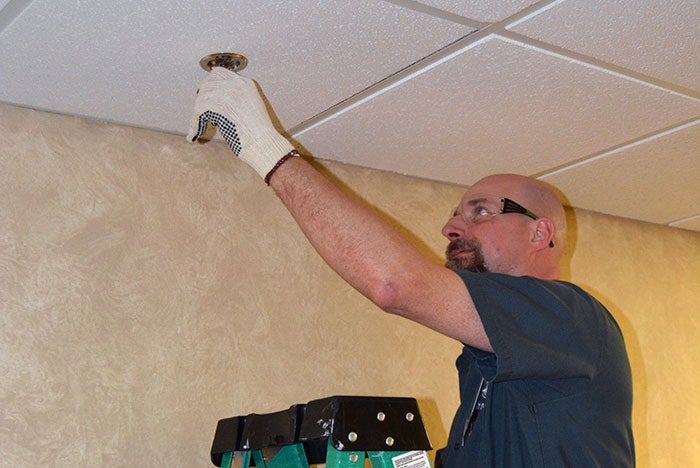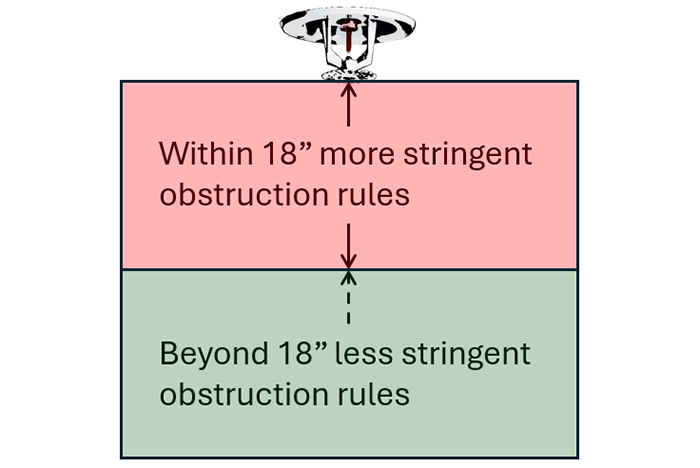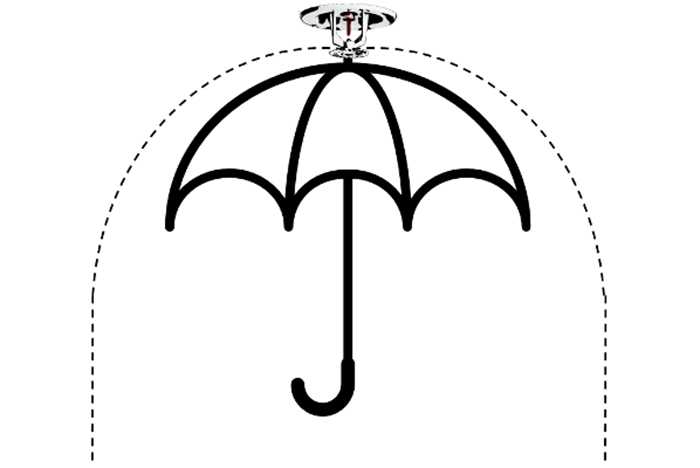Understanding and resolving sprinkler obstructions

Health care facilities can ensure fire sprinklers operate as designed by keeping coverage areas free of obstruction.
Image courtesy of ASHE
Citations for sprinkler obstructions have been on the rise, prompting the need to explore the key functions of a sprinkler system and guidelines for addressing obstructions.
At its core, a sprinkler system is designed to automatically spray water onto a fire as soon as the fire grows large enough to activate a sprinkler head. This critical function provides occupants more time to evacuate, helps contain the fire’s spread, reduces overall damage and supports firefighters in their response efforts.
Because fires can start anywhere, sprinklers must be able to reach any area within a building to perform effectively. This means they must remain clear of anything that could block water from reaching specific areas. But how exactly can one avoid obstructions?
The National Fire Protection Association’s NFPA 13, Standard for the Installation of Sprinkler Systems, provides requirements. This article will focus on the standard’s 2010 edition as it is the version being enforced by the Centers for Medicare & Medicaid Services at the time of publication.
Back to basics
Before diving into the details, it’s important to understand the basics of what a sprinkler is and the definition of a sprinkler obstruction.
What is a sprinkler? Although different types exist, at its core a sprinkler consists of a metal body with a hole for water to flow through, a plug that holds the water back, a thermal element that keeps the plug in place and a deflector that helps evenly distribute water when it flows.
Sprinklers can be installed in various orientations, with the most common being:
- Pendent. The deflector is on the bottom of the sprinkler.
- Sidewall. Installed horizontally to project water out to the side.
- Upright. The deflector is on the top of the sprinkler.
Additionally, sprinklers can be installed in recessed or concealed configurations. Concealed sprinklers are particularly common and are designed to blend in with their surroundings. They typically appear as a thin metal circle on the ceiling, often painted by the manufacturer to match the ceiling’s color.
What is an obstruction? An obstruction is anything that prevents sprinkler water from reaching a potential fire. When an obstruction blocks the water, the fire may grow unchecked, potentially overwhelming the sprinkler system.
Common obstructions include surface-mounted light fixtures, ceiling fans, decorations, cabinets and structural elements. These challenges are especially common in walk-in refrigerators and freezers, where shelving and storage items can inadvertently block the sprinkler’s spray.
Types of obstructions. NFPA 13 classifies obstructions into two main categories. The first category includes any obstructions within 18 vertical inches below the sprinkler. This area has stricter requirements because an obstruction here can prevent the sprinkler’s water spray pattern from forming properly. It’s similar to the shadow cast by a flashlight: the closer an object is to the flashlight, the larger the shadow it creates. Likewise, the closer an obstruction is to the sprinkler, the larger the area that won't receive water.
The second category covers obstructions that fall below the 18-inch threshold. Since the water has had enough distance to begin developing its spray pattern, the obstruction rules in this area are less strict and typically only apply to obstructions wider than 4 feet.

Fire sprinkler obstructions as defined by NFPA 13 are categorized into two major categories.
Image courtesy of author
Clearing the area
Sprinklers discharge water in a pattern that resembles a wide umbrella, and obstructions should be kept outside of this "umbrella" area. Details about the exact shape and dimensions of the area that must be free of obstructions can be found in Table 8.6.5.1.2. in the 2013 edition of NFPA 13, but the basic principle is this: the farther an area is horizontally from the sprinkler, the farther down an obstruction can extend vertically. However, keep in mind that as one moves farther horizontally, adjacent sprinklers may be encountered. For any sprinkler obstruction measuring wider than 4 feet, additional sprinklers are required to be installed underneath the obstruction.

The general area that must be free of sprinkler obstructions is similar to an umbrella-shaped pattern.
Image courtesy of author
Floor-mounted and vertical obstructions. Obstructions don’t always hang from the ceiling; they can also come from the floor. The rules for floor-mounted and vertical obstructions are similar to those for ceiling obstructions. As with the umbrella-shaped spray pattern of a sprinkler, the lower an obstruction sits, the farther away horizontally it needs to be positioned from the sprinkler.
There is an exemption for vertical obstructions such as privacy curtains commonly found in patient care areas. This exemption has three key requirements:
- The curtains must be supported by a fabric mesh attached to a ceiling track.
- The openings in the mesh must cover at least 70% of the curtain's area.
- The mesh portion must extend at least 22 inches from the ceiling.
Privacy curtains that meet these requirements are not considered obstructions because the mesh allows heat from the fire and sprinkler water to pass through without significantly affecting the sprinkler’s discharge pattern or activation time. This exception applies only to light-hazard occupancies, which is the occupancy type of most patient care areas.
Three times rule. The “three times rule” found in NFPA 13 states that “sprinklers shall be positioned away from obstructions a minimum distance of three times the maximum dimension of the obstruction.” For example, if a ceiling fan hub measures 4 inches by 7 inches, the sprinkler must be positioned at least 21 inches away from the hub. This rule is commonly applied to smaller obstructions that are located near the sprinkler.
Storage. There must be at least 18 inches of clearance between the top of storage and any sprinklers above it. A common way to ensure this is by marking a line on the wall 18 inches below the sprinkler. This line serves as a visual reminder for occupants to avoid stacking storage too close to the sprinklers.
Obstructions against walls. For obstructions against a wall, facilities managers can apply what is sometimes referred to as the “soffit rule,” since it also applies to soffits and ductwork against a wall. For any obstruction that is against the wall and less than 30 inches wide, facilities managers can use a formula found in NFPA 13 that tells how far away horizontally the sprinkler needs to be from the obstruction. See the formula below:

Courtesy of author
Ceiling fans. Ceiling fans also can fall into the obstructions category. However, in light-hazard occupancies, facilities only need to consider the central unit of the fan and not the blades, as long as the blades cover less than half of the area in question when viewed from directly below or above. The central unit of the fan should be positioned according to the “three times rule.”
Other sprinkler reminders. Additional important requirements related to sprinkler obstructions include the following:
- Never hang anything from the sprinkler or its piping, including wiring; signs; ceiling grids; heating, ventilating and air-conditioning ducts; or even zip ties.
- When painting, be sure not to get paint on the sprinklers as this can damage them and delay activation.
- Damaged or compromised sprinklers must be addressed immediately. A damaged sprinkler will not function as intended. This can include issues such as residue buildup, physical damage, corrosion or missing escutcheons.
Safe operations
To maintain the effectiveness of sprinkler systems, it’s essential to keep them clear of obstructions that could hinder their operation. Following the requirements in NFPA 13, including ensuring proper clearance, applying the "three times rule" and understanding specific exceptions, helps ensure sprinklers can activate and perform as designed.
Regularly addressing potential obstructions and maintaining the integrity of the sprinkler system play a crucial role in protecting both lives and property in the event of a fire. By staying informed and proactive, health care facilities managers can help prevent issues that may compromise the system’s ability to respond when it matters most.
Brian O’Connor, PE, is a senior engineer at the National Fire Protection Association.

